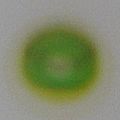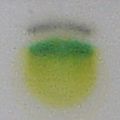Thin layer chromatography facts for kids
Thin layer chromatography (often called TLC) is a cool science trick that helps us separate different things mixed together. Imagine you have a smoothie, and you want to see all the fruits that went into it separately – TLC is a bit like that for tiny particles!
TLC uses a special plate, usually made of glass, with a thin layer of a material called silica on it. Think of silica as super-fine sand. This silica layer is very important and is called the stationary phase because it stays still.
Contents
How to Do a TLC Experiment
Doing a TLC experiment is pretty neat. First, you take a tiny drop of the liquid mixture you want to separate. You carefully put this drop near the bottom of the TLC plate. This is called "spotting" the plate. People often use very thin glass tubes, almost like tiny straws, to do this.
Once your plate is spotted, you place it gently into a glass container. This container has a small amount of another liquid called the solvent. This solvent is known as the mobile phase because it will move. It's super important that the solvent level in the container is below where you spotted your mixture on the plate.
Watching the Separation Happen
Now, the magic begins! The solvent (mobile phase) starts to climb up the TLC plate, soaking into the silica layer. This happens because of something called capillary action, which is how liquids can move up narrow spaces, like water climbing up a paper towel. As the solvent moves up, it carries the different parts of your mixture with it.
The amazing thing is that the parts of your mixture will separate! Some parts will be more attracted to the moving solvent, so they will travel further up the plate. Other parts will stick more to the stationary silica layer, so they won't move as far. This separation happens because of differences in something called polarity, which is like how "sticky" different chemicals are to each other.
You should take the TLC plate out of the container before the solvent reaches the very top.
Seeing the Separated Parts
Sometimes, the separated parts of your mixture will have different colors, so you can see them easily. But often, they are invisible! Don't worry, there are ways to make them appear.
One common way is to put the TLC plate under a special ultraviolet lamp. Many compounds will glow under UV light, making them visible. Another way is to dip the TLC plate into a special stain, like anisaldehyde or potassium permanganate. These stains react with the compounds and make them show up as colored spots on the plate. You can also use iodine vapor to make spots appear.
What TLC is Used For
TLC is a really useful tool for scientists, especially those who work with organic chemicals.
Checking Chemical Reactions
One main use of TLC is to check how a chemical reaction is going. Imagine you're trying to bake a cake, and you want to know if all the ingredients have mixed together properly. Scientists use TLC to see if their starting materials are turning into the new products they want to make. They can check a single TLC plate to see if the old ingredients are disappearing and the new ones are forming.
Planning Bigger Separations
TLC can also help scientists plan bigger separation jobs. If they have a large amount of a mixture, they might use a technique called column chromatography to separate it. TLC helps them figure out the best solvent to use for this bigger separation. They might try different solvents or even mixtures of solvents to see which one separates the components best on the TLC plate. The better the separation on the small TLC plate, the better it will be for the larger separation.
Images for kids
See also
 In Spanish: Cromatografía en capa fina para niños
In Spanish: Cromatografía en capa fina para niños








